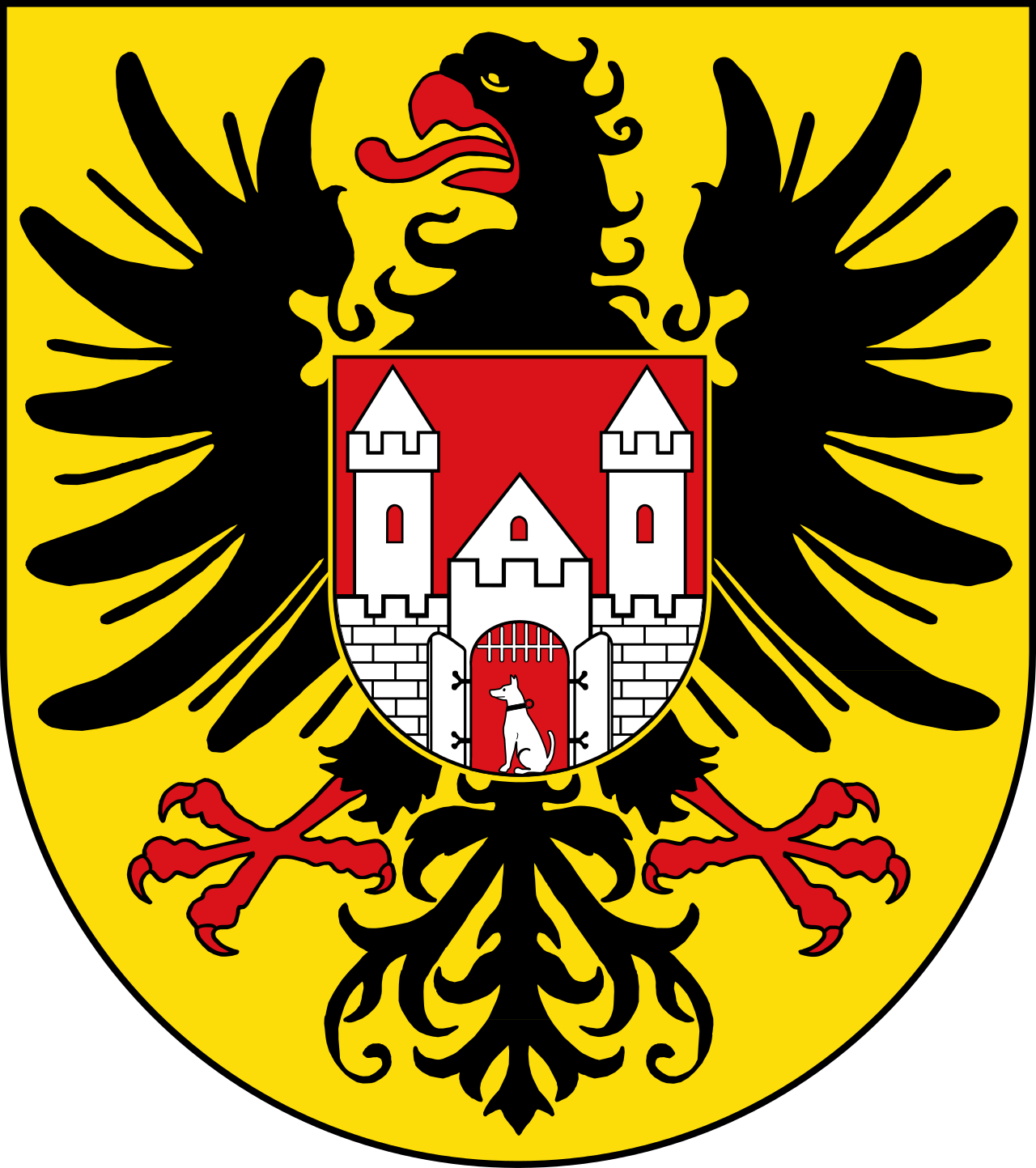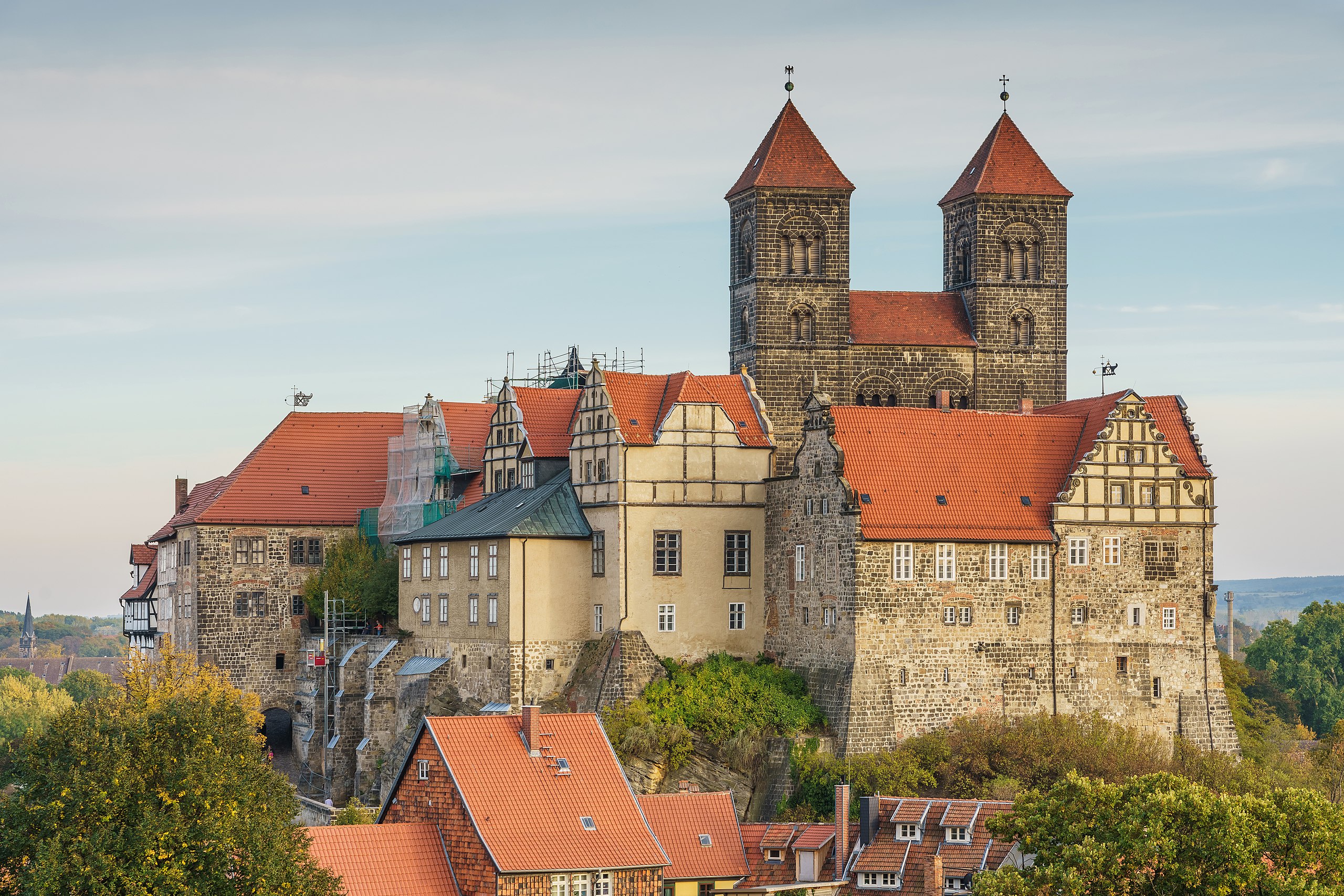

Quedlinburg - Castel Hill



 |
 |
Quedlinburg - Castel Hill |
 |
 |
 |
| POI |
||
Situated on a sandstone cliff, the more than a thousand year old Romanesque collegiate church St. Servatius towers as an imposing landmark over the city. The flat-ceiling basilica, dedicated in the year 1129, was preceded by earlier structures. The monumental sandstone edifice manifests not only in its facade but also in the ornamentation of its interior walls and capitals strong Lombardic influences. The Gothic form of the choir erected over the crypt can only be seen from the outside of the building. In the interior of the church, the attempt was made to recreate an impression of purely Romanesque architecture through the addition of an apsis wall. The interior space is articulated in accordance with the lower Saxon alternation of columns and pillars as a principle of construction. This progression of columns and pillars divides the nave from the aisles. In the west, the emperors loge is the demarcation defining secular and consecrated space within in the church. In the east, a stairway leads up to the choir and to the vault rooms where the famous collection of the Quedlinburg church treasures have been on display since 1993. In the crypt beneath the choir are the royal graves of the first German King, Henry the1st, and his wife Mathilde. Facing the church is a building that houses the former residential, representational and the functional rooms of the abbesses and personnel of the Quedlinburg ladies collegiate chapter. This structure underwent its final architectural transformation into a Renaissance castle in the 16th and 17th centuries and now houses the castle museum under the direction of the Quedlinburg municipal museums. The Quedlinburg castle-hill is in danger. Not only are the sandstone cliff and along with it the famous Romanesque church St. Servatius endangered. Numerous half-timbered houses in this city designated since 1994 as a UNESCO world heritage are also at risk. On numerous occasions in the history of the town there have been static problems with the church. Already in 1571, the south wall of the St. Servatius transept was endangered, and in 1708 the south wall of the long house had to be partially reconstructed. The central problems derive from the sandstone cliff, which is in desolate condition as the result of the number of structures that have accumulated on it over the years. Some buildings extend even beyond the actual sandstone plateau of the hill. Ever larger constructions were erected on top of the cultural debris of the past, and no adequate provisions were made to divert water from the castle-hill. |
||
| Castle Museum | ||
Schlossberg 1 This museum, housed in a Renaissance castle from the 16th / 17th centuries, provides visitors with an overview of the stone-age and early history of the region and of its earliest medieval settlements. Also presented is the development of the castle hill from the fortress castle of Heinrich I to the secular womens collegiate convent with close ties to the imperial family. Important aspects of the history of the city are illuminated as well. Amongst the most important objects exhibited are the findings from a bronze-age hoard on the Lehof and the golden broach from Groß-Orden. Legends abound in regards to the \"Robber Counts Box, a wooden prison cage associated with the capture of Count Albrecht II of Regenstein which can be viewed in the museum. The Historical Library of Quedlinburg, whose holdings were collected in Baroque times, reflects not only the history of Quedlinburg but also the intellectual and cultural history of the entire German speaking realm. Today it is maintained by the museum as a research library. Appointments for access to the holdings in a reading room can be arranged in consultation with the Director of the Historical Library, Margid Reitzammer. (Tel. 03946/ 905686) The representational rooms of the castle offer insight into the living style of the nobility in the 17th and 18th centuries. The successful restoration of these rooms was carried out so as to authentically reflect their state in the eras of the Baroque and of Classicism. The Ottonian vaulted cellar of the castle is the site of a comprehensive permanent exhibition, \"Following the Tracks of the Ottonians. The visitor receives introductory information on the history of the fortress castle of Quedlinburg and its Ottonian rulers. The exhibition then focuses on the beginnings of the secular womens imperial collegiate convent, founded by Heinrich I in the year 936, and its historical development. International treasures of art, including, for example, the oldest remains of German stucco decoration (10th century) in the German speaking realm give this room its particular authentic flair. The pursuit of the tracks of the Ottonians in this exhibition leads past the middle ages up into the 19th and 20th centuries. Under the title \"History and Propaganda, the question is posed as to how and why Quedlinburgs medieval history was appropriated and abused, above all, by the National Socialists. Entry Prices: Adults: 4.00 Visiting Times: |
| Photos | ||||||||||||||||||||||||
 |
|
| Bâtiment | Collections - Expotision - Events | Visite - Promenade | |||||||||||||||||||||||||||||||||||||||||||||||||||||||||||||||||||||||||||||||||||||
|
|
||||||||||||||||||||||||||||||||||||||||||||||||||||||||||||||||||||||||||||||||||||||
|
|
|
|||||||||||||||||||||||||||||||||||||||||||||||||||||||||||||||||||||||||||||||||||||
| A voir |
|
|
| A faire |
|
|
| Type | Caractéristiques | Evaluation | |||||||
| Histoire |
| Photos | ||
| Contact - Nom | Téléphone / gsm | web | note | |
| info | ||||
| réservation | ||||
| office |
| Heures d'ouverture | Fermeture suppl | |||||||||
| Hours: Mardi - dimanche 11:00 - 18:00 | Tickets: jusque |
Jeudi | ||||||||
| lundi | mardi | mercredi | jeudi | vendredi | samedi | dimanche | 1 janvier |
|||
| Basse saison | 9 mai | |||||||||
| Haute saison | 31 décembre | |||||||||
| Prix | Entrée gratuite | Paiement - Cartes acceptées | ||||
| Adulte | Adulte > 60 - 65 | Etudiant | Enfant | Groupe | The third Thursday of a month (except May, June, July, August) | |
| Services, facilités | ||||||||||||
Audioguide |
Langues |
Wifi |
Photo - Vidéo |
Shop |
Consigne |
Vestiaire |
Cafetaria |
ATM |
Visite guidée |
|||
| A proximité |
|||
| Musées, expositions | Restaurants, Hôtels | Parcs, promenades | Divers |
| Itinéraire | ||||||||
| Mode | De | A | Distance | Durée | ||||
| Mode | Lieu | Prendre | Jusque | Vers | Orientation | Distance | Durée | |
 |
 |
 |
 |
 |
 |
 |
 |
 |
  |
 |
 |
  |
||||
| Avions | Trains | Métros | Trams | Bus | Minibus | Trolley | Transfer | Voiture | Location Voiture |
Taxi Safari | Parking | A pied | Vélo | Téléphérique Funiculaire |
Cheval | Navigation |
 |
|||||||||
| Connections | |||||||||
| Sites web | ||